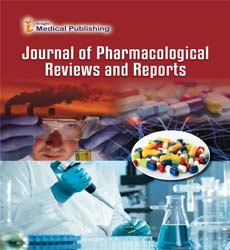Pharmacology of Ramipril
Harvey Martin*
Department of Pharmacology, Claude Bernard University, Lyon, France
- *Corresponding Author:
- Harvey Martin
Department of Pharmacology
Claude Bernard University
Lyon, France
E-mail: martin@harvey.gmail.com
Received Date: December 2, 2021; Accepted Date: December 16, 2021; Published Date: December 23, 2021
Citation: Martin H (2021) Pharmacology of Ramipril. J Pharmacol Rev Rep Vol.4 No.3:006.
Description
Ramipril is a pro-drug that belongs to the class of Angiotensin Converting Enzyme (ACE) impediments. It's metabolized to ramiprilato in the liver and to a lower extent in the order. Ramipril is an important and competitive asset of ACE, the enzyme that converts angiotensin I (ATI) to angiotensin II (ATII). ATII regulates blood pressure and is an important element of the Renin-Angiotensin Aldosterone System (RAAS). Ramipril can be used to treat hypertension, congestive heart failure, nephropathy and reduce mortality, heart attack and stroke in people at high threat of cardiovascular events for the treatment of mild to severe hypertension. It can be used to reduce post-myocardial infarction cardiovascular mortality in hemodynamically stable subjects who show clinical signs of congestive heart failure within days of myocardial infarction. To reduce mortality, heart attack, and stroke in people at high threat of cardiovascular events. It can be used to decelerate the progression of order complaint in people with hypertension, diabetes, microalbuminuria or overt nephropathy.
Ramipril is an ACE asset analogous to benazepril, fosinopril, and quinapril. It's an inactive prodrug that's converted to ramipril in the liver and feathers, which are the main spots of activation. Ramipril has an antihypertensive effect by envenoming the effects of RAAS. RAAS is a homeostatic medium for regulating hemodynamics, water and electrolyte balance. Renin is released from the scrap cells of the juxtaglomerular outfit of the order by sympathetic stimulation or dropped renal blood pressure or blood inflow. In the bloodstream, renin cleaves the circulating angiotensinogen to ATI and also to ATII by ACE. ATII raises blood pressure through several mechanisms. First, it stimulates the stashing of aldosterone from the adrenal cortex. Aldosterone travels to the Distal Tubule (DCT) and collects nephron tubules. Thus, we increase the immersion of sodium and water by adding the number of sodium channels and sodium potassium ATPase on the cell membrane. Second, ATII stimulates the stashing of vasopressin (also known as antidiuretic hormone or ADH) from the posterior pituitary gland. ADH further stimulates water reabsorption from the order by fitting aquaporin 2 channels into the apical face of DCT cells and the collecting tubules. Third, ATII raises blood pressure by direct arterial vasoconstriction. Stimulation of ATII type 1 receptors on vascular smooth muscle cells triggers a series of events leading to muscle cell compression and vasoconstriction. In addition to these main effects, ATII provokes a thirst response through stimulation of hypothalamic neurons. ACE impediments block the rapid-fire conversion of ATI to ATII and offset the RAAS-convinced increase in blood pressure. ACE (also known as Kininase II) is also involved in the enzymatic inactivation of the vasodilator bradykinin. Inhibiting bradykinin inactivation may increase bradykinin situations and maintain the goods of ramipril through increased vasodilation and dropped blood pressure.
Mode of action
Ramipril blocks the RAAS system by clinging to and blocking the ACE, precluding the conversion of angiotensin I to angiotensin II. Dropped tube situations of angiotensin II reduce activation of the G protein- coupled receptor angiotensin receptor I (AT1R) and angiotensin receptor II (AT2R). AT1R mediates vasoconstriction, inflammation, fibrosis, and oxidative stress through a variety of signalling pathways. These include Gq coupling to the inositol trisphosphate pathway, activation of phospholipases C, A2, and D that contribute to eicosanoid product, Ca2 dependence and activation of Chart kinase, Gi and G12/13, and Includes final activation. Jak/STAT pathway this leads to cell growth and product of extracellular matrix factors. Activation of AT1R also leads to an increase in the exertion of membrane-bound NADH/NADPH oxidase, which contributes to the product of reactive oxygen species. This reduced receptor activation mediates the renal defensive, antihypertensive, and cardio protective effects of ramipril by reducing inflammation and vasoconstriction. AT2R counteracts the effects of AT1R by inhibiting Chart kinase, blocking the opening of Ca2 channels, and cranking phosphotyrosine phosphatases that stimulate the product of cGMP and nitric oxide leading to vasodilation. These negative effects are actuated by Ang (1-7), a subtype of angiotensin produced by AngI's tube esterase, or by AngII's ACE2 produced by Tonin and CatepsinG by secondary metabolic pathways. Shared by the receptor Ang (1-7) also activates AT2R, but utmost of its effects are intermediated by MasR. ACE is also responsible for the breakdown of bradykinin. Accumulation of bradykinin by ACE impediments is allowed to intervene dry cough, which is a characteristic side effect of ACE impediments.
Open Access Journals
- Aquaculture & Veterinary Science
- Chemistry & Chemical Sciences
- Clinical Sciences
- Engineering
- General Science
- Genetics & Molecular Biology
- Health Care & Nursing
- Immunology & Microbiology
- Materials Science
- Mathematics & Physics
- Medical Sciences
- Neurology & Psychiatry
- Oncology & Cancer Science
- Pharmaceutical Sciences
